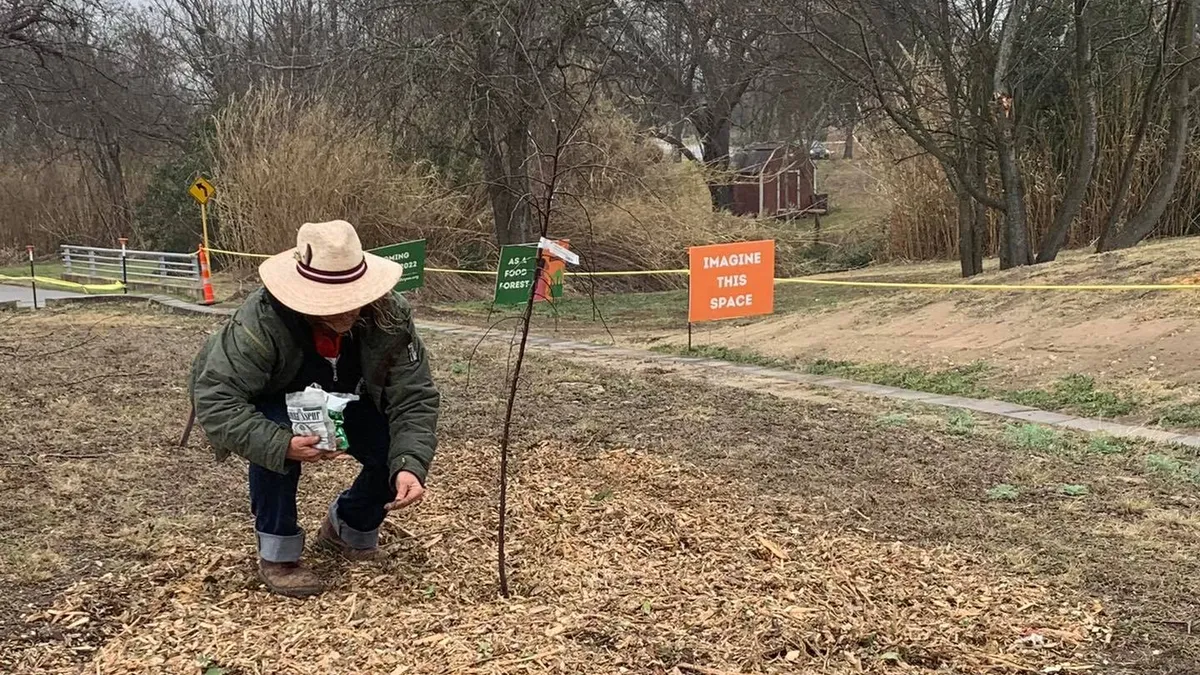Dive Brief:
- Urban farms and food forests are “extremely productive” and have the potential to address local demand for food and build equity even in highly developed areas of San Antonio, concludes a May report by the Stanford University-based Natural Capital Project presented to a San Antonio City Council subcommittee last week.
- Urban farms — plots in cities where produce is raised to be sold — can yield more food than urban food forests, which are self-sustaining, often publicly accessible areas planted with perennial crops such as fruits and nuts, the report finds. However, food forests can provide more co-benefits, such as urban cooling, green space access, carbon storage and flood retention.
- Both types of spaces have tangible financial benefits, the report says. For example, a recently established food forest in San Antonio will pay for itself once it’s mature and in production, when accounting for the market value of crops — estimated to be $87,000 annually — as well as carbon storage and urban cooling benefits.
Dive Insight:
San Antonio’s work to spur urban agriculture and food forests comes amid growing interest in how nature can be used to build more climate-resilient, equitable communities.
Increasingly, communities are realizing that urban agriculture can play an important role in these efforts, said Mitchell Hagney, a co-author of the report, chair of the Food Policy Council of San Antonio’s Urban Agriculture Committee and CEO of urban agriculture company LocalSprout.
“As the next couple of decades roll on, I think we'll see scaling of agriculture as green infrastructure in cities,” Hagney said in an interview. “San Antonio is just one example.”
San Antonio already has 51 acres of urban farms, large community gardens and about 72 acres of urban food forests. But it aims to add more, the report says, pointing to several City Council comprehensive plans that codify the goal.
As a thought experiment, the report models the impacts of converting all underutilized, publicly owned land in San Antonio to either urban farms or food forests. Conversion to food forests would provide over 192 million pounds of food — worth $995 million — and save $3.5 million in cooling costs annually. Conversion to urban farms would provide over 926 million pounds of food — worth $1.17 billion — annually but likely increase nutrient pollution in adjacent areas.
Despite those benefits, urban agriculture often can’t rival the immediate financial return of the commercial or residential real estate interests competing for land, Hagney said. “While there's a huge, really impressive return on investment for the agricultural products themselves, potentially those are not as much as apartment complexes or strip malls or other faster-return investments,” he said.
That’s why San Antonio is particularly interested in siting urban agriculture in flood plains, which are less likely to interest other real estate developers, Hagney added.
The monetary value of urban agriculture should never be the only factor driving land use decisions, said Anne Guerry, chief strategy officer and lead scientist of the Natural Capital Project at Stanford University. “It's really important to have community input and to think about, what do we want our city to look like?” she said. “What makes this a livable place? What expresses the character of this place?”
Workforce development is another barrier to scaling up urban agriculture, Hagney said. Even if San Antonio only decided to cultivate a quarter of the hypothetical acreage modeled in the report, the city “currently doesn't have a workforce that's experienced enough in agricultural production to be able to do that.”
Cities should select the crops they cultivate based on their cultural views and regional growing environment, which may evolve with climate change, Hagney added. Some crops may even need to be accompanied by education initiatives, he said, highlighting the loquat, a yellow-orange fruit that thrives in San Antonio but isn’t consumed heavily by residents.
“The loquats, while they grow extremely well, might not be the best candidate to cultivate in areas of food insecurity because they might not get maximized use,” Hagney said. “By contrast, pecans evolved in this region. Historically, they're important to cultural labor movements here. They're integrated into the diet really closely, and they're well-adapted to both flood times and really serious summers.”
Guerry echoed Hagney’s point. “With nature-based solutions, it's critically important to think about what makes sense ecologically and culturally in ways that we haven't ... with those more engineered solutions,” she said.
The report recommends several policies that could increase urban agriculture in San Antonio. They include expanding community access to agricultural equipment, making certain public lots available for a long-term lease for urban farmers and integrating strategies to install and maintain food forests into parks and public works departments’ land management plans for public space.
But many questions remain in San Antonio, as the city hammers out next year’s budget and figures out how to move forward with the report’s insights, Hagney said.
“Where's the money going to go? Where's the money going to come from? And what sites typically are going to be managed?” he said. “And once that happens, if urban farms and food forests are installed, what does the long-term maintenance strategy look like? Are those subcontracted out or are they managed directly by city staff?”












